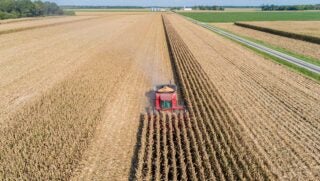We are in the middle of the information age, and everything is becoming more technological: people, jobs, communications, and farm equipment. While the general public may be surprised by the last one, farmers aren’t. Today tractors, planters, combines, sprayers, harvesters, and all kinds of other agricultural equipment are collecting data every time they pass over a field. The Agricultural Data Coalition is working to improve the storage of the data that is collected.
This data can help farmers analyze how much fertilizer to apply and where it is needed or where exactly to plant seeds and how far apart. It can also help track yields from entire fields, including variances. This technology has helped remove some guess work from farming. The bottom line: It helps today’s farmers become more efficient and productive.
Technological innovations are beneficial for farmers and the industry, but it can be confusing and time-consuming to store and analyze all of the data gathered. Because of this, farmers usually cannot process the data right after it is collected. In many instances, there is no easy way to store this data for later use.
Another hurdle is that it is sometimes unclear who owns the data and when farmers can access it or allow others to access it. That can sometimes be a disincentive to try new technology or find new information from analyzing that technology. The ADC is working to improve storage of this important data.
The ADC, founded this year, is a coalition of entities across the agriculture industry: private companies, equipment companies, land grant universities, law firms, farm bureaus, and others. The mission of the ADC is to focus on designing, creating, and managing a central repository where farmers can store their information and oversee how it is accessed.
That can be kind of confusing, Matt Bechdol, executive director of the ADC, explained it in a much more relatable way. “Think about it like we’re opening a safety-deposit box that growers are in charge of and always have the ability to access.”
The benefits of this safety-deposit box system is that farmers will be able to store data in one central location, and then share that data with multiple trusted partners easily at one time, whether that be ag companies for research, data companies to analyze it, or land grant universities for study.
Data storage and usage is also usually time-consuming. The ADC wants farmers to be able to focus more time on other decisions instead of worrying about how and where to store their data. Currently few farmers are utilizing their data as much as possible. Once there is a central storage location, usage should become streamlined and more productive.
“One of our main goals is to educate producers to help them understand the value of their data,” said Bechdol, who is also president of GeoSilos. “People are willing to pay for this data, so why shouldn’t the growers benefit?”
A cooperative format will allow farmers to be the ones to profit through shares that are returned to its members.
It’s obvious how individual farmers and growers can benefit from the ADC, but how can the industry benefit? Well, having one place to store the data allows for standards to be set. Those standards lead to improving the consistency and quality of data. Right now, each farmer and each agency has a different storage system and rules – this makes analyzing the data and combining the results difficult. It also hinders technological advancements from the data.
Once that data is safely stored and correctly analyzed and shared with stakeholders, that’s when the big changes can start happening. These improvements might lead to new product development or accelerate the research of genetics, chemicals, or engineering. New innovations can also come through the market faster.
“This era of data-driven agriculture is important for farmer profitability, innovation, and stewardship,” Bechdol explained. The ADC does not plan to compete with the industry, but instead connect with the industry professionals to focus on innovation.

Bechdol also explained that the coalition will be beneficial because it’s not just industry representatives and university partners; it’s everyone working together for the betterment and advancement of agriculture.
“The diversity shows that we’re in it for the greater good,” Bechdol said. “We’re in it for the farmers. This coalition will help make growers more profitable, more efficient, and more environmentally friendly.”
That is exactly what the agriculture industry needs, to work together instead of having different sectors fighting each other. This repository would give everyone involved in agriculture a way to bond together and better each other and the industry.
“Data collection isn’t just for ‘big ag’; it has the capability to help the entire industry,” noted Dan Alfaro, communications coordinator for the ADC. This has the capability of helping everyone involved, from the large commercial farms to the smaller organic farms.
So where is this coalition headed? In the next few weeks it is entering its pilot phase. It will be working with growers, producers, farmers, and university researchers to find out specifically how they use data, and assessing their pain points. The ADC hoping to be public about this process, along with offering opportunities to participate.
Another goal of the ADC is to teach users to best utilize their data through continuing education and training. This goal will be achieved through a nonprofit organization that focuses solely on that purpose. So not only is the ADC providing a sort of safety-deposit box for farmers and growers to easily store their data, but it is going to make sure that everyone involved will know how valuable their data is and how to best use the information.
We expect great things from this diverse group. If you are interested in finding out more information about the Agricultural Data Coalition, visit www.agdatacoalition.org.



